Search the Community
Showing results for tags 'garrett axiom'.
-
Hi all, My new Axiom is the wireless package with the 13x11 DD and 11x7 Mono coils. Initially I will be using it to patch hunt in unfamiliar areas rather than cleaning up old known patches. I'm thinking the 13X11 DD would be an okay choice to use even though a 13x11 Mono might punch deeper. I may have to drop down to the 11x7 Mono in brushy tree covered areas. Any advice on this strategy will be greatly appreciated. I own a GPZ 7000 but it gets heavier each year. If I locate a patch or two I can bring out the big gun. 💪
-
16 DD Coil 948g SC 188g = 1136g (2.504 lbs) 16 Mono 766g SC 188g = 954g (2.103 lbs) 13 DD 750g SC 156g = 906g (1.997 lbs) 13 Mono 598g SC 156g = 754g (1.662 lbs) 11 DD 518g SC 74g = 592g (1.305 lbs) 11 Mono 424g SC 74g = 498g (1.098 lbs) Coil Bolt + Two Rubber Washers = 10g (0.022 lbs) Garrett Axiom 16”, 13”, and 11” search coils, both DD and mono
-
Is it possible to pair wireless earbuds directly to the Axiom for hot weather use? Or is the wr-1 and corded earbuds the only/best option?
-
.....well no, actually, I killed the monkey that was riding my back for the last 15+ days detecting (3 years) without joy. The Axiom lent the assist that was needed to get back amongst the living. First time out with the Axiom in tough ground, this modest .60 grammer saw the light of day, from 5" down. This is a big step up from the PI I was using previous. I used the 11 x 7 mono and was impressed with the hot top corners. Started out at sens 4 but got a little conservative and fell back to a stable sens 3. I can see that once you get some time on the Axiom, you will be more comfortable in pushing its limits. My confederates who run 2300's were impressed with how hot the 11 x 7 was.
-
These are not my videos, but a series being posted by Randy’s Treasure Adventures starting a couple weeks ago, with the last just posted today. I’ll add more if any appear later. I don’t know Randy or anything about him, and frankly I’ve not even watched the videos. I’m sure something can be gleaned from them one way or the other though by those that watch videos so here they are. Mar 12, 2023 I spent a few days in the Arizona gold fields recently and here is the first of several videos comparing the Garrett Axiom to the Minelab GPX6000. They’re not the same, but how different are they from a results standpoint? Mar 18, 2023 Scouring a hillside in the Bradshaw Mountains with the Garrett Axiom, looking for a nugget patch. The Axiom is light, powerful, and well balanced for this task! Also a little view of operations on one of our claims with a fun quad ride. Mar 22, 2023 Another day comparing the Axiom to the GPX 6000. I could not help myself and had to film multiple waterfalls, and in this video, you only get to see a sample of the waterfalls that I stopped and and took video of. The high desert in Arizona is just so picturesque. It’s hard not to lose focus and just take pictures!
-
The focus while designing the Axiom was 100% on the nugget detecting aspects. But I do think it will end up finding favor with some relic and coin hunters also. I will add information and videos about the subject to this thread as I come across them. This is my best "not nugget" find with the Axiom so far is a silver 1914 sixpence I accidentally found while nugget detecting in Australia.
- 6 replies
-
- 5
-

-
- coin detecting
- relic detecting
-
(and 1 more)
Tagged with:
-
From everything I've read on the Axiom from Steve H. and others I can see no reason not to trade in or sell my 5000 to offset costs in purchasing an Axiom. It's a difficult decision for me as I have found a lot of gold with the 5000 over the years. Can anyone give me a reason not to do this? I have several coils from the 8x6 to the largest for the 5000. From what I can see the only con is maybe a lack of coils at this time for the Axiom. However looks like that will change with time. For use in Northern California and the Mojave for gold prospecting. Thanks for your thoughts in advance.
-
I had gone into an old past producing mine last week. I had brought my axiom with the 11" mono and my friend had his sdc2300. I had hit a very suttle signal on the wall in a 1" thick blanket seam, my friend scanned it with his sdc2300 and could not pick up a signal. I chiseled out 4" of the wall around the target, the suttle signal turned into a banger. Ended up being a 1 oz pay zone of 3"w 4"L not a crazy amount but no complaints and always thankful. All the gold was thin and laying flat so the detector was only picking up the edges, which makes a huge difference for depth. I took my vlf gold kruzer to clean up all the non pi gold. I replaced my sdc2300 for the axiom im pretty happy with my decision. Incase anyone is wondering is was in "fine" mode, full sensitivity, no head phones, max vaolume, max threshold, tone @ 60, speed on slow. Ground track off, basically default settings except sensitivity, tone and speed. I normally run head phones in which i should have to block out the sound of the coil scraping the walls and background noise but i didnt have my headphones thats why i max out everything as for volume,threshold and sensitivity. I think volume amd threshold are maxed by default. With headphones i run 4-6 on sensitivity depending. I dont notice a difference on small,large, shallow, deep targets from max sensitivity to default except overall volume, youll still hear targets in reach. Good luck out in the gold feilds.
-
What's happened? the talk on the Axiom I mean, it's gone quiet on here and in oz. I know it's off season but there must be a few out there now. I have had a little play with one and like it. And about to buy. But I suppose if the Axiom was giving any trouble it would soon be out there, wouldn't it? Cheers all.
-
Not an update for the Detech coils, but for anyone looking to add an additional Garrett coil to their Axiom. It looks like accessory coils are becoming available through a few dealers, starting with the 11” x 7” DD. That worked for me, I wanted that coil originally but didn’t want to sacrifice the MS3 headphones to get it. Price was around $205 with free shipping. Just received mine last Friday. Of note the Axiom package you purchase comes with coils that have pre-installed removable protective covers. Accessory coils do not include these protective covers so you just need to swap with one from your set until Garrett gets those on the market. I assume the only exception might be for the 16” x 14” accessory coils. Those might ship with a cover installed since Garrett seems to want to set you up for success with at least one cover of each size. Just a guess.
-
Hey guys I was our this weekend at gold eye claim in Quartzsite AZ was using the mono that came with the kit there were guys with GM1000's and 1 GPX6000 both were killing it with small nuggets I couldn't even pickup what they were finding and the Garrett was noisy no matter what I did grant it i didn't know about the gb window only the standard pump and hold button until it beeped also my head phones keep disconnecting and picking up noise unless I'm right next to head of detector. Not sure if I'm doing something wrong but the first time I took it out with another friend who has an Axiom and we both found multiple target at the 1.grain size could the noise and loss of sensitivity be from the gm100's and the GPX6000 please help im ready to send it back to see if there's an issue
-
Field Test: Garrett Axiom By Bill Paxton For those of you who are frequent readers of Western and Eastern Treasures, you may recall back in December of 2021 I did a field test on the Garrett 24K Goldmaster metal detector. An excellent VLF gold machine, the 24K was Garrett’s rebranding of the White’s 24K Goldmaster and a perfect legacy choice to honor the White’s brand that they had acquired in October of 2020. Since the 24K Goldmaster was not a Garrett-developed product, I was very curious as to what Garrett had in the works for 2022. While their competitors were literally leapfrogging each other in the hobby market, Garret was curiously quiet. What were they up to I wondered? A new detector based on the Multi-Flex technology they had introduced in the Apex? Maybe a new water machine? The months ticked by. Still Garrett was quiet. Then came October 5, 2022. That was the day that Garrett revealed to the metal detecting community that their company was all in when it came to one thing. Gold. The 24K Goldmaster was a precursor of things to come. Or to be more specific, one amazing thing to come. The Garrett Axiom. A complete from the ground up redesign of pure pulse induction technology in a package unlike anything that had ever been seen before in the gold prospecting niche of our hobby. Gone were the bulky rigs that required harnesses to swing them and car-size batteries to supply power. No more annoying nobs and confusing settings. What Garrett delivered was a genuinely new and yes, I’m going to say it, exciting metal detector. The first pictures of the Axiom looked like something out of the space age. This was a detector that I wanted to try out and I’m not even a gold prospector. When Steve Moore, the Director of Marketing for Garrett, emailed me and asked if I would like to try one out I couldn’t type the word “YES!” fast enough. Let me pause here briefly and give you a bit of a spoiler alert regarding this field test. As you can tell from the introduction I’ve written above, the Axiom got me pretty revved up even before I held one in my hand. I have used it in the gold fields and at the beach and it flat out delivers. This metal detector is a game changer and I’m genuinely excited to share this field test with our loyal readers. With that being said, let’s get to the field test. The Garrett Axiom The Garrett Axiom There is a great deal to cover on the Axiom beginning with its design. As you can see from the photos, when I describe the Axiom as looking like “something out of the space age” I wasn’t kidding. I’ve used PI detectors for many years, primarily to hunt saltwater beaches because of their inherent ability to deal with high mineralization and find targets at extreme depth. They did, and do, work but at a cost. Due to their often bulky designs, they can beat you up physically. Walking on a beach for several hours with one of those beasts takes its toll and the fatigue factor inevitably shortens your hunts. The Axiom completely negates that negative aspect by its well-balanced and relatively lightweight design. It comes in at roughly 4.5 lbs. depending on the coil you select and features a lightweight internal lithium battery encased in a molded plastic case. An open flexible and very comfortable arm cuff is mounted on the rear of the detector and can be adjusted if required. The hand grip is easy to grasp and topped by a control box modeled after the Apex. A slick carbon fiber shaft that uses innovative stem clamps for adjustment connects to a variety of lightweight coils. All of this means just one thing: you can swing this detector for hours and not suffer for it in the least. One more thing. When you are transporting the Axiom, or if you wish to shrink it down to hunt in close quarters, it easily collapses to a remarkable 25”. The stem clams work as promised and save you the hassle of pushing in those annoying little spring buttons every time that you adjust the shaft. The Axiom Package The Axiom Package Garrett provides a very impressive package of accessories with the Axiom. Along with the detector and searchcoil (this can vary by the package selected), you get: Axiom Booster Pack Soft Carry Case Quick Start Guide Warranty Card USB Charging Cable Wall Charger and Adaptors A set of MS-3 Wireless Headphones with charging cable (Yes, you get Z-Lynk with the Axiom!) A small gripe is that a copy of the full owner’s manual is only available online. I really like a printed copy for reference and wish that one was included. Axiom Coils Garrett offers a large selection of coils for the Axiom: 11” X 7” Mono AND DD 13” X 11” Mono AND DD 16” X 14” Mono AND DD Okay, you are probably thinking that the above listing of DD coils for the Axiom are typos. I can assure you they are not. Yes, Garrett has chosen to offer DD coils for the Axiom. For many PI purists this may be heresy since Mono coils have been the standard for PI detectors for many years. However, I can tell you that the DD coils are a great way to go. My test unit came with a 13” X 11” DD coil, along with Mono coils in the other two sizes. Unlike the Mono coils, which are hotter on the edges, the DD coils react to a target like a typical DD coil and are hotter toward the middle of the coil. I personally loved this because I hunt 100% of the time with DD coils on my other detectors and it made for a very easy and intuitive switchover to the Axiom. In comparing it to the mono coils I found no loss in either depth or sensitivity and the DD coil is now my coil of choice. I would not discount a DD if you are looking into purchasing an Axiom. Axiom Power Okay, say this with me. “Ahhhh.” That is what you will say when you pick up an Axiom and see that there is not any bulky battery to deal with. The detector is powered by what Garrett describes as a “2X LIFE” built-in, high-capacity lithium-ion battery that will run 16 hours on a full charge. I can confirm that the battery is exceptional in terms of holding a charge. While I didn’t hunt for 16 hours straight, I did numerous back-to-back hunts totaling over 10 hours each time and the detector always had two bars remaining on the charge indicator. For those of you who just want to play it safe, a separate booster pack battery powered by 8 – AA batteries is included that will supply an additional six hours of hunting time. Axiom Display Panel When Garrett introduced its first multi-frequency metal, the Apex, it featured a brand-new control box design that users instantly embraced. I was very happy to see that Garrett chose to utilize this same design for the Axiom. The display screen features fifteen different elements in a neatly uncluttered arrangement: Signal Strength Indicator Iron Check Mode Frequency Scan Tone Audio Type Sensitivity Battery Level Speed Ground Track Backlight Wireless Headphones Ground Balance Arrows Ground Balance Indicator Ground Balance Values These display elements will be discussed in detail where relevant later in this field test. Axiom Controls Axiom Controls As with the Apex, the six controls on the display box are located in a unique, user friendly “thumb wheel” pattern below the display. All operations and adjustments to the Axiom are easily accomplished by moving your thumb from left to right in order to press the appropriate button. The controls are: 1. Power ON/OFF and Operate a. Used to turn the Axiom on and off. Pressing and holding this button for five seconds restores factory settings. This button also can be tapped to exit the MENU settings. 2. Volume Plus/Minus Buttons a. Used to increase/decrease volume. 3. Sensitivity Plus/Minus Buttons a. Used for two functions. i. To adjust the sensitivity of the detector. ii. To adjust detector settings within the Menu settings. 4. Menu/Iron Check a. Used for two functions: i. Used to access Menu settings. ii. Engaging Iron Check function by pressing and holding this button. b. Ground Balance i. Press and hold this button to ground balance the detector. 5. Threshold Plus/Minus Buttons a. Really handy to increase or decrease the threshold on the fly as opposed to have to go into some sort of annoying settings menu. 6. Ground Balance a. A “hold and bob the coil” button for ground balancing the Axiom. With all the aforementioned features and controls you might think that the Axiom is a complicated detector to run. On the contrary, Garrett really took its time in designing the Axiom to both offer many features AND be easy to operate. After spending many hours in the field with my Axiom I can attest to this. Axiom Functions and Settings Accessing the various functions and settings is extremely intuitive. · How many times have you owned a detector that needed a factory reset and you couldn’t figure out how to do it? Not with Axiom. Press and hold the Power button for five seconds. Listen for a double beep. Done. · Frequency Scan o EMI is a constant enemy a detectorist must battle so frequency scan is a must with today’s modern metal detectors. The Axiom uses a unique system to locate the quietest operating frequency. To perform a Frequency Scan, just push the menu button until FREQSCAN is highlighted, then press the plus button. The Axion scans through 100 frequencies, rechecks the best five and automatically selects the best one. All of this in 45 seconds. This worked flawlessly for me in the field. · Detection Modes o In my humble opinion this is the Axiom’s finest feature. The Axiom provides four search mode operations, each optimized for specific types of detecting. 1. Fine Mode · The preferred search mode of the Axiom, Fine Mode offers the best sensitivity to all sized targets ranging from fine gold to large items. Fine Mode can be susceptible to ground minerals, hot rocks and salt water. 2. Normal Mode · An excellent choice if noise issues are encountered when in Fine Mode. Normal mode provides good sensitivity to most targets but can be less effective on fine gold. 3. Large Mode · For use when focusing on large targets. This mode also reduces susceptibility to hot rocks and highly mineralized ground. 4. Salt Mode · Designed to allow for use of the Axiom in wet salt environments like ocean beaches. As an avid beach hunter, I was particularly interested in how this mode performed. It delivered excellent stability even in high concentrations of black sand. o Accessing the modes was a sinch. Just press the MENU button until the word “MODE” is highlighted. Then press the “PLUS” or “MINUS“ buttons to select the mode. · Volume and Threshold Adjustment o Not much to say here. Super easy to adjust with the PLUS/MINUS buttons. · Tone and Audio Options o Another area where the Axiom shines. Via the Menu button, the user can change the audio pitch and select from two different types of audio. 1. Tone Adjustment · Pushing the Menu button until TONE is selected followed by pressing the +/- buttons allows for scrolling through 100 available tone shifts. o This feature allows the operator to pick a tone that best fits their preferences or hearing ability · Only active with VCO audio (Audio 01) o Audio type 1. The Axiom has two different and very unique audio types, Audio 00 (PWM) and Audio 01 (VCO, also default). These can be accessed by pressing the Menu button followed by the +/- buttons. Both provide continuous audio that responds proportionally to a target’s signal strength allowing the operator to judge a target’s size, depth and shape. · Audio 00 (PWM) o In PWM audio, audio pitch is fixed at either high or low and only the target’s volume increases with signal strength. Preferred by users who like an active, coarse audio response. 1. Audio 01 (VCO Audio) o The preferred mode of most users (including yours truly). Target volume and audio increase proportionately with signal strength and is a real asset in locating faint targets by changes in audio pitch. o Target Signal 1. The Axiom features a Target Signal Strength Indicator at the top of the display. Utilizing a bargraph, the indicator will display high tones proportionally toward the right of center and low tones similarly toward the left of center. · Backlight o The backlight can be activated and adjusted via the Menu button by highlighting the backlight icon. o The backlight automatically activates when scrolling through the menu, a very handy feature. · Speed o A crucial adjustment for your hunting, made easy by the Axiom’s defined speeds of SLOW, MED(IUM) and FAST. This adjustment determines coil sweep speed and also target recovery speed (often referred to as “reactivity). o As with every adjustment on the Axiom, the Menu button gets you to the Speed Settings. The operator needs to pay strict attention to choosing the proper setting in order to ensure the Axiom performs at its best. 1. SLOW · While the manual suggests using the MED setting for general purpose hunting my preference was the SLOW speed. This setting was the most stable of all three and provided excellent depth and sensitivity. However, it is vital that the user sweep slowly. I always ask the question of fast sweepers “what’s your hurry?” In the case of the Axiom, go slow and you will be rewarded. 2. MED(IUM) · The default setting and a good general-purpose selection for most users. It provides good sensitivity and depth and requires a moderate sweep speed. 3. FAST · This speed boosts reactivity to increase target separation but that comes at a cost. EMI and noise chatter can increase making it more difficult to hear faint targets. · Sensitivity o Unlike most metal detectors, the Axiom offers what I would refer to as “sensitivity on steroids.’ While many metal detectors can be run hot at max sensitivity, the Axiom for the most part cannot. Prior to its release, the previous maximum sensitivity of “8” was boosted significantly to allow certain skilled operators in unique hunting situations to push performance to the maximum. The previous maximum sensitivity now is the number 4 selection. For almost all users (including this field tester), 4 provides more than enough power to obtain excellent results from the Axiom and should not be exceeded for general hunting. · Ground Balance o The Axiom features a very sophisticated ground balancing system that is covered in detail in the manual. While offering standard options like manual ground balance and ground tracking, the Axiom has taken ground balancing to another level with several innovations not previously seen on PI metal detectors: 1. Dual ground balance values displayed with both ground tracking on AND off. · This is a terrific visual reference to monitor ground conditions. 2. Ground Balance Window Feature · After ten seconds of ground balancing, the Ground Balance Window activates and allows the operator to eliminate both mineralized soil AND a hot rock. Pumping over the soil and scanning over the hot rock will eliminate both responses (or make them much smaller). · Iron Check o One of the coolest innovations included in the Axiom. Iron check, which only works with DD coils, will generate an iron “buzz” that is easily recognized. To activate this feature just hold down the Iron Check button until it double beeps. Then scan and listen to the buzz. o While this feature worked best on shallow targets, I found it to be a huge asset for both gold prospecting and beach hunting. If I had a deep, small target all I had to do was activate Iron Check and then scan the pile to see if it was iron or not. This was a real time saver and I used it a lot in my testing. · Quickstart and Owner’s Manual o A Quickstart guide is included with that Axiom. The owner’s manual, which is very well written, is only available as a downloadable pdf. · Other references. o Once again Garrett smartly brought in renowned gold hunter Steve Hershbach to host a series of “how-to” videos explaining the Axiom and its use in great detail. Steve’s easy-going manner and excellent on camera skills, combined with his in-depth knowledge of electronic prospecting, make these videos a must see for anyone contemplating the purchase of an Axiom. I found myself going back to them many times and even after learning the Axiom found they served as a huge, free database of knowledge that made me a more skilled operator of the detector. And now on to the field test… Field Test Historically PI detectors have been at their best when it comes to gold prospecting and saltwater beach hunting. These were the two areas that I focused on for my field testing. But before we get to that, let me comment on one aspect of the Axiom that deserves more than just a passing reference. What is that aspect? Its design. I don’t mean anything specific because to focus on just one feature would be unfair. This detector is flat out one of the best designed metal detectors that I have ever had the pleasure of using. The more that I use it the more I appreciate the time that Garrett put into its design. Notice I said “more that I use it.” Having been a field tester of metal detectors for over two decades I can tell you that this is not always the case. I have never tested what I would call a “bad” detector, but on occasion certain detectors take a toll on you just to use them. For example, the grip angle is wrong. Or the balance is off. Or the menus are confusing. Not with the Axiom. Its performance was excellent as you will see shortly. But what really continues to make my day is that the Axiom is just an easy and enjoyable detector to hunt with. Now let’s get to that field test. In the Gold Fields Living in Los Angeles it is difficult to prospect for gold regardless of your method. Getting to areas to look for gold that isn’t in the form of jewelry is especially difficult, although there are certain places where you might have success that are relatively nearby. However, in my mind I wanted to really prospect for gold with the Axiom so I decided to focus on a place you might have heard of: the Mojave Desert. A few hours’ drive from Los Angeles, this massive area holds many gold claims and a ton of history. Through a fellow detectorist I was able to gain access to a mining claim that was known to still be producing gold. Six buddies and I piled into two pickup trucks and we headed out to the desert to make our fortune on a clear Friday morning. Our detecting site, high up in the Mojave Desert Mountains The site we came upon was several miles up in the hills and showed clear evidence of mining activity. Tiling piles were everywhere. We parked and unloaded out detectors. FYI, I had the only pulse machine; my buddies had both multi-frequency units and VLF’s. After having studied Steve Herschbach’s videos the night before (thank you again, Steve!) I felt pretty confident in my ability to run the Axiom so off I went into the land of tailings. Getting started with the Axiom was a breeze: Power up. Adjust threshold - I preferred a barely audible threshold although at times I went with a negative value to run totally silent. In both cases good targets rang through clear and solid. Ground Balance Run Frequency Scan Pair MS-3 Wireless Headphones (optional) - Being out by myself I liked using the speaker but if noise is an issue the MS-3 Wireless Headphones are excellent. Select Detection Mode - I ran Fine Mode exclusively and was very impressed with its sensitivity to all sizes of targets. In the area I was hunting there was no need to utilize either Normal or Large Mode. Go! Over the course of the next six hours, I covered a lot of ground with the Axiom. Targets were few but when there was something there, large or small, the Axiom found it. I really liked the Iron Reject feature in that it allowed me to locate and ignore several tiny ferrous targets in the pile once they were removed from the hole. Having never prospected for gold with a metal detector for this long a period of time I was grateful for the Axiom’s user-friendly design. The main reason? Gold prospecting is hard work! The constant digging in rock hard ground with a pickaxe kicked my butt. The author working a hillside with the Garrett Axiom For those of you who aren’t PI users, there is an audio adjustment that you have to make when using a PI in order to recognize targets. I would strongly urge you to test targets at home before going out in the field. Thankfully I did this and therefore was able for the most part to locate targets easily. Using the DD coil really helped and I was able to use my VLF skills to center and pinpoint targets with very little difficulty. The Axiom found targets of various sizes that included shell casings, bullets, wire, iron junk (ID’d easily by Iron Reject when in the pile), everything but gold. As those of you who prospect for gold know all too well, gold is tough to find and on this day I did not come home with any. The Axiom will find even the tiniest piece of gold as was evidenced by several microscopic bits of wire that hit hard with good, solid repeatable signals. The Axiom was sensitive to both large and very small targets in the heavily worked area. The irony of the day was that one of our party did find gold and he was the only guy who did not use a metal detector. He filled up two large buckets with dirt to take home and pan out and yes, he had gold in his pan when he was all finished. At the Ocean Beach As an avid beach hunter living in Southern California I was really anxious to see how the Axiom performed in a salt environment. Until the advent of multi-frequency detectors, PI’s ruled when it came to depth and performance at ocean beaches. Nowadays you don’t see a lot of PI’s at the beach but they do still have their place when the mineralization is high and causes problems for conventional detectors. There are still PI purists who will argue that a PI can beat any detector for pure depth and they may be right. I had no intention of reopening that debate. All I wanted to do was see if the Axiom could serve as a beach hunting detector. The Axiom was rock solid at ocean beaches and delivered exceptional depth on targets. A long-buried silver ring with an onyx stone was found with the Axiom after a recent storm. The verdict: yes, it can. Thanks to the SALT mode, a beach hunter can easily navigate “the wet” as we call it and punch right through troublesome black sand. In my hunts at the beach I was very pleased with how smoothly the Axiom ran. I could push the sensitivity up to “6” before I had to deal with any falsing. Targets were recovered at impressive depths of well over a foot. Being a PI, some of these were deep garbage but others were coins. That is the compromise you make when hunting with a PI. My best find was a very old, large silver ring, found at a depth of about 6” in a pocket of black sand. The Axiom hit it with no problem. I might add that the Axiom’s relatively light weight and excellent ergonomics made for easy, fatigue-free hunting, something that I have not found to be true of other bulky PI’s that I have used in the past. Another type of beach gold hunting is one that few detectorists explore, that being microgold hunting. For those of you who aren’t familiar with micro-gold hunting, it involves searching for those tiny pieces of gold that VLF metal detectors can’t find. Items like earring backs, thin chains, gold fillings, etc. Gold detectors can be used with good success when searching for microgold due to their ability to find tiny pieces of gold. This type of hunting must be done on the dry since the salt content of the wet sand will wreak havoc with these types of detectors. It requires a great deal of patience since the dry sand holds many types of small bits of metal that conventional VLF’s will not find. It is not for everyone. However, if you elect to try this type of hunting then the Axiom is a superb choice thanks to its FINE MODE. Be sure to bring your Garrett Pinpointer along because you will need it. The Axiom will hit on microscopic pieces of metal like aluminum that you will not see easily with the naked eye. I did a several hour microgold hunt at a local ocean beach and was amazed at how many small targets the Axiom located. If it had been my lucky day, I’m certain some of them would have been gold. Summary, Due to unforeseen circumstances that I will get to in a moment, I was able to spend a much longer period of time using the Axiom than normal. While its gold prospecting abilities have been well documented by many users since its release, there has not been as much focus on the detector as a general use machine, in particular at saltwater beaches where PI’s historically have always performed well. Being a beach hunter, these extra few months gave me multiple opportunities to use the Axion “in the salt” as the saying goes. Generally, I have avoided using a PI as my go-to beach detector because they can be a pain in the neck to use due to their weight, confusing adjustments (for me at least) and the requirement that you have to dig too much garbage. Not that I haven’t tried almost all of them and really tried to love them, or at least like them. The Axiom changed that for me. It is the first PI that I have ever used that was fun to hunt with and performed and felt like a normal metal detector to me. Each time I used it I came to appreciate its brilliantly designed. As a gold prospecting PI I don’t think you can match its performance and value. For saltwater beaches I found it to be a match for any detector that I encountered during my hunts, including all of the latest and greatest multi-frequency machines. If you are looking for a powerhouse saltwater beach detector don’t write of the Axiom as being just a gold prospecting detector. It is a whole lot more. I cannot recommend it more highly as a multi-use metal detector. You can learn more about the Axiom here: https://garrett.com/sport/axiom. Now let’s get to those unforeseen circumstances. This field test was requested by Garrett Electronics and was slated to be published in the January 2023 issue of Western and Eastern Treasures Magazine. I was due to deliver it for publication when the news was released that the magazine was closing its doors for good at the end of 2022. Despite all the work I had put into testing the Axiom and writing up my field test article, it just didn’t seem right for me to keep the unit. I contacted Steve Moore, Director of Marketing for Garrett Electronics, to arrange for the return of the Axiom. To my pleasant surprise, Steve insisted that I hold on to the Axiom and finish my field test in the hope we could find another method of publishing it. Enter Steve Herschbach of DetectorProspector.com Steve said he would gladly publish this field test. He also added that it would be an honor to have it be the last field test written for Western and Eastern Treasures Magazine. To say I was flattered would be an understatement. With that being said, I hope you enjoy this field test of the Garrett Axiom, the last field test written for Western and Eastern Treasures Magazine.
-
I received an Axiom last week. I too was surprised how light-weight the unit is. I'll be able to backpack into the remote locations without any problems. The build quality seems very good. I've never operated a pulse induction detector before so I'm on the beginner's learning curve. I will be doing some field comparisons with the XP Deus I have. I hope to understand the differences in the two detector type capabilities. Thanks for the tutorials posted. I've watched them twice and taken notes. Ed, Saddlebrooke, Az
-
I held an Axiom today! A new tester/reviewer has one and he showed it to a few of us. It is very light and well balanced with a solid 'stick' sort of feel. I didn't get the sense of a coil heavy device. Reminds me of the Equinox with the 6" coil. It sounded great with the onboard speaker. I'm sure if they are not near a release date, he can provide a present evaluation to be considered. I'll see it again tomorrow and maybe use it.
-
When people familiar with metal detector coils hear certain terms, they think certain things. Here are the three classic coil designs, illustrated in many articles in books, magazines, and the internet. Mono and DD coils are common, concentric much rarer with modern VLF and PI detectors. A classic mono transmits and receives alternatively with a single coil winding, and so is only used on pulse induction detectors. DD and concentric separate the transmit and receive into two separate windings, and so can be used in both PI and VLF designs. Metal detector coil types illustrated - concentric vs DD vs mono Garrett has some unique coil designs, but refers to them by the old terms. This leads to some confusion and incorrect assumptions about how the coils will perform. In a classic sense, a mono combines the transmit and receive into a single coil. Since depth is connected to how large the receive coil is, a mono often had better depth on larger targets than a similar size DD coil. The DD has separate smaller transmit and receive coils enclosed in a housing the same size as the equivalent mono. The smaller receive area often puts the DD at a disadvantage compared to a mono for depth on larger nuggets. A mono tends to be hottest on small gold very near the winding, around the edges of the coil. A nugget next to the winding gets the most benefit from both the transmit and receive phase, since the one winding is doing both. This leads to an odd effect with the smallest gold, where a mono coil has a soft, or non-existent signal in the middle of the coil. A clue to small surface nuggets is when a mono coil gives a double blip, one on each edge of the coil as it passes over the nugget. A classic DD coil tends to have a milder response to small nuggets, since over a lot of the coil surface a small nugget is far away from either the transmit winding, or the receive winding. As a result, with small nuggets you get the best response in a narrow band down the middle of the coil, where the transmit and receive coils overlap. In the last decade mono coils have been more popular than DD coils on pulse induction detectors for that edge on larger gold depth, and users have learned to hunt with the edges when chasing the smallest gold. But DD coils have some inherent advantages in ground cancellation and EMI handling, and Garrett decided to try something different when they made DD coils for the ATX. The main complaint was how narrow the response was on a standard DD coil, so what would happen if that area was opened up, made larger? Here is what they came up with: The coil is wound like a standard DD, but the winding crossover is not at the toe and heel, but in the middle where the inner coil area is created. This creates a coil within a coil, and the secret to the Axion DD is that this is what is inside the solid exterior. It is not a standard DD, but a "Focused Core" DD, with a strong target area in the middle of the coil. Please excuse this quick and dirty diagram I just whipped up. I may replace it later, but it gets the idea across. Winding layout inside the Garrett "Focused Core" DD coil The tones refer to the two different tones a PI detector will make on targets. The small item hi-lo tone, and the large item lo-hi tone. The design of this coil results in more complex tone responses than on a normal DD coil. This can be confusing at first, but actually gives a trained operator extra information about the size and depth of the target. Small targets will "tone-flip" front to rear, with the classic hi-lo tone in the center. Larger targets at depth will no longer tone flip, but just deliver a stand hi-lo or lo-hi response. Here is the super critical information I wanted to get across in this post. People just automatically tend to assume mono coils are better on a PI detector, due almost everyone using them. Yet we have seen more interest in some concentric PI coils lately, which have a strong center response due to the way the windings are laid out. The Garrett DD is a unique coil in a class all its own, and it offers a very strong alternative as a small gold coil compared to their mono coil. With the mono and the smallest nuggets, you need to focus on the edges as where the hottest small gold response. With the Garrett DD, it is a more classic response in the middle of the coil. Anyone used to hunting with a coil and assuming the center is where you are going to get the best signal will take right away to the Garrett DD for hunting small gold nuggets. The only caveat is you have to really focus on that center area as being the hunt area of the coil, and overlap your swings appropriately. Axiom Focused Core (FC) DD Coils from Garrett Metal Detectors on Vimeo. Keep in mind that the Axiom Iron Check only works with the DD coil. I would submit that a really savvy operator, who pays close attention to the tone flipping characteristics in conjunction with the Iron Check feature, will be able to predict the nature of targets with the Axiom, better than any other PI yet devised. It will not be a VLF. It is something in a class by itself, and if you have a good ear for target responses on PI detectors, the Axiom offers a wealth of information to play with. In closing, just do not forget this. Do not automatically assume the Axiom mono is your best choice and ignore the DD. It is a very bad habit many of us have fallen into, and I was guilty of this myself. I ran the mono almost exclusively early on. But then I made myself use the DD coil, and was surprised to find the more I used it, the more I liked it. All the gold I found on my last trip to Australia was found with the 11" DD coil, which has the same setup internally. It just seems more natural to me to be focused on the center of the coil instead of the edges when chasing small gold nuggets. It is also a quieter coil than the mono, which also helps when running higher sensitivity levels in bad ground. The Axiom 13"x11" DD has a hotspot that is about 6"x5" in the center, where you should focus your efforts on smaller gold. The 11"x7" DD has a very hot 5"x4" center zone, roughly illustrated below. As a final reminder, there are six coils available now, or very soon, for the Garrett Axiom. There mono, and three DD. All three of the DD designs including the 16" DD are actually the Garrett "Focused Core" DD in disguise. These coils are not protected by chips or anything that would block third party support, so I expect we will see more coils soon, either from Garrett, the aftermarket, or both.
-
These coils cables are thicker than any other that I have used. So flexing the coil up to run your scoop over it shouldn't be a problem in the long run.
-
As you all know, I unfortunately got a dud Axiom. Contact from Garrett Australia, zero. Very poor. Contact from Garrett USA, zero. Also poor but that’s why you have distributors in each country. Problem resolved by dealer in record time. Now have a normally functioning Axiom and like it so much I sold both my 6000’s. However, the simplest of things has me wondering about the level of intelligence available to those who make the decisions at Garrett. Allow me to elaborate. Here in Western Australia, (what I would assume to be a major market), it’s hot. Tomorrow is 42 degrees Celsius or 108 Fahrenheit. Has anyone at Garrett, Australia or USA, ever detected in this environment or considered the requirements to do so? Headphones are impossible to use unless you want to jacuzzi your ears. Also impossible with a decent wide brim hat and fly net. Inbuilt speakers are only just ok but absolutely cost you gold especially if even a minor breeze gets going. Simple answer, (and a must have to be successful in the heat), ear buds. Problem solved. But how to have them wireless? Again, simple. Just order a WR-1 and get into it, right? Not quite that simple though. Contact my local and previously mentioned awesome Garrett dealer to order a couple of WR-1’s. But Garrett Australia says no longer available? How can that be? Retailers in USA have them listed and available ex stock? Ok, so just order from USA. Couple weeks and in business before the heat really gets here. But no, dealers in USA are not permitted to ship Garrett products internationally and refuse to supply. WTF? Ok, aftermarket alternatives like I had with 6000. Ooops, Z-Link is proprietary and nothing will work. Alternatives? Stuff around with cables, transmitters, receivers, amplifiers and other crap strapped to Axiom and me for hundreds of dollars (and adding weight so reducing one of Axiom’s advantages over 6000), to try and make it work when the perfect product is small, light, inexpensive and actually manufactured but not available??? Is Garrett Australia run, like so many companies now, by an accountant with a laptop, night school marketing degree and has never held a detector let alone made a living from using one? Why have a system like Z-Link but not have the components available? Why wouldn’t Garrett USA recognise that and make it a requirement for all their international distributors to stock WR-1 for use with Axiom? Or even include it in the Axiom package? An extra $100 at this price point would be irrelevant. So, choices are, hard boil my ears in headphones and not wear a decent wide brim hat or spend at least 5 times the price of WR-1 on aftermarket crap to make something work. Garrett drops the ball again
-
I’m taking the plunge on one of these new detectors as the old body needs something lightweight. When the SDC came out and again the GPZ, I went over old patches and pulled out ounces of nuggets that were invisible or had to be within an inch of the coil on the previous GPX 5000 and before. That spongy and wiry stuff. The Axiom is much more in line with what I want as I sometimes detect old tailings and like the option for iron disc. Plus the price is better. But, I want to be sure the Axiom hears the “invisible” stuff as well as the 6000. Can anyone of you knowledgeable and generous folks share your experience with this before I take put down the cash?
-
Don't overtighten the cam locks thinkin you're gonna get rid of a little up and down shaft wobble. I JUST SNAPPED one......
-
Since the Axiom uses a 4-pin coil connector and the GPX 5000 coils used a 5-pin connector (pin 5 was not used), is there a possibility that GPX 5000 coils can be used by changing to a 4-pin connector? Some of us still have GPX coils in our closets.😁 Bill
-
Took the Axiom out for another quick spin before the rains this afternoon. I ran through all the combinations of speed and modes on sensitivity 2 to re-check my findings from the other day. The beach I went to is on the extreme end condition-wise; that is to say the sand is heavily mineralized and there is lots of airplane traffic. The first photo is near the bottom of the slope, and the second photo was taken mid- slope. Again, I ran the machine in a silent search-type mode to eliminate some of the ground noises. As before, Mode= NORMAL & Speed= Medium was slightly more workable than Mode= SALT & Speed= SLOW. SENSITIVITY.................2 MODE............................Normal SPEED...........................Medium THRESHOLD................-8 The bottom of the slope was workable with the 13 x 11 DD but going up the more mineralized slope rendered the Axiom too unstable. Most beaches are not this mineralized, so this is the worst-case scenario. The Axiom, fitted with a smaller DD coil, would be able to handle this ground. I use an Eric Foster designed Goldquest Aquasearch v.2 and have to dumb the machine down at times here. Even then, the threshold is still a bit ratty and you have to work slow. To be fair to the Axiom, I will next go to a beach that is not so extremely mineralized and see how it performs. So far, I am not disappointed with how the Axiom has fared with the 13 x 11 DD coil. -Jerry



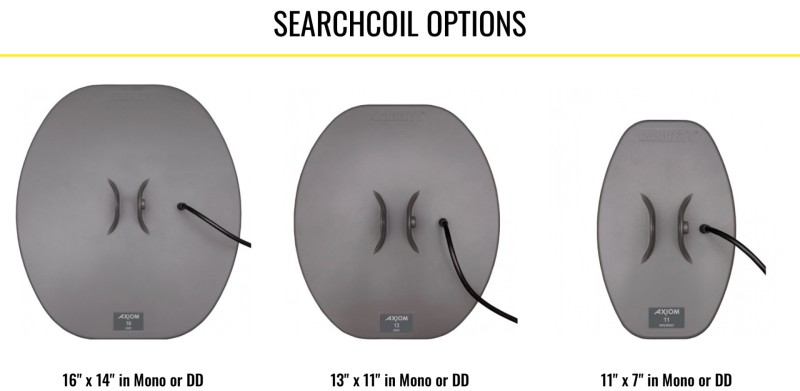



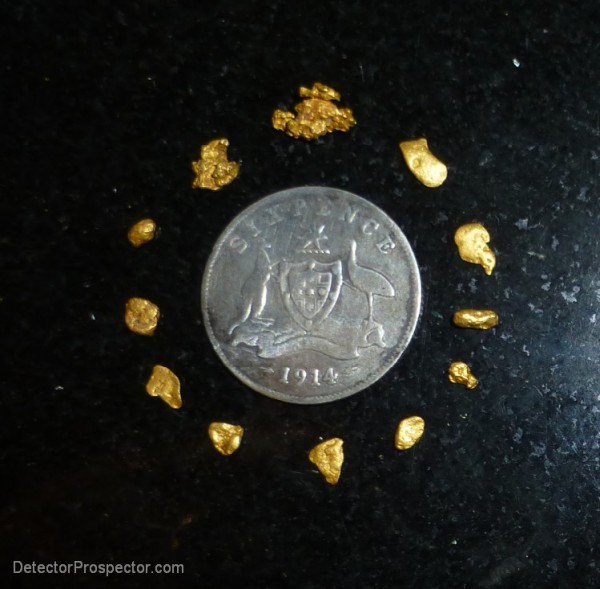

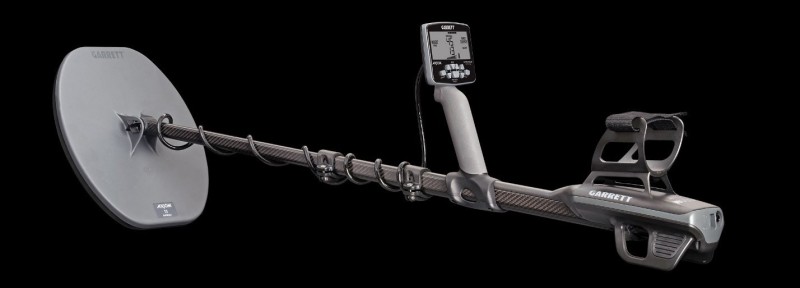
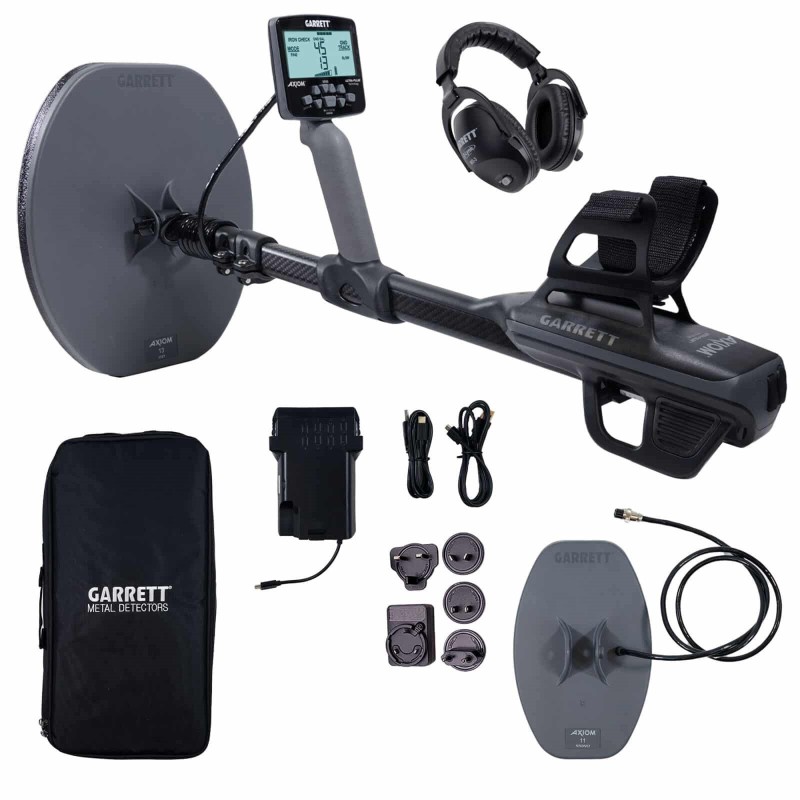
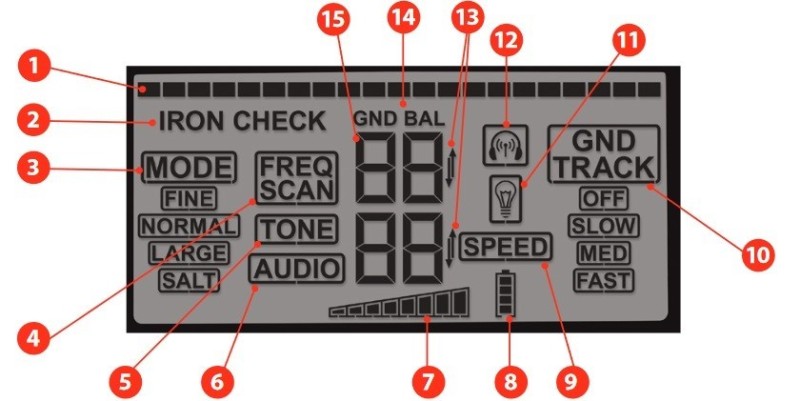
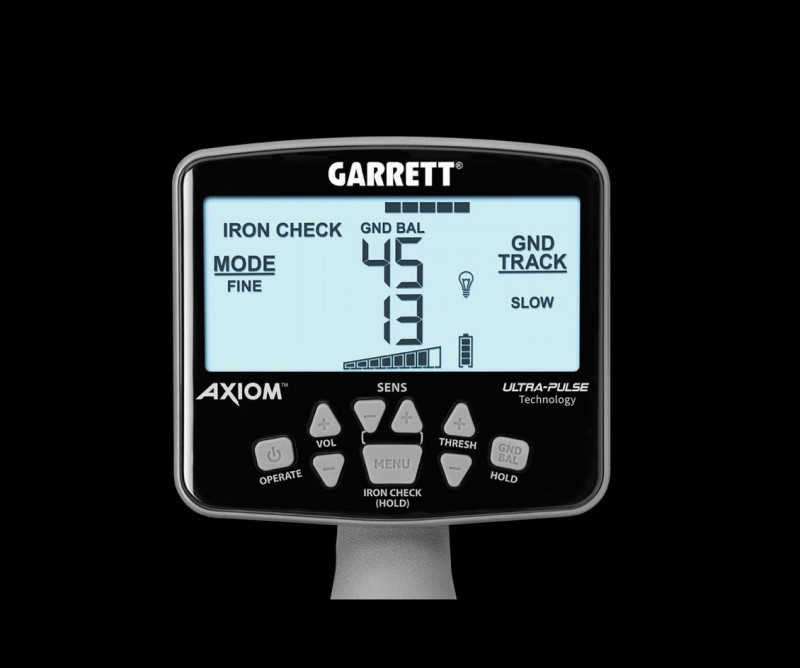
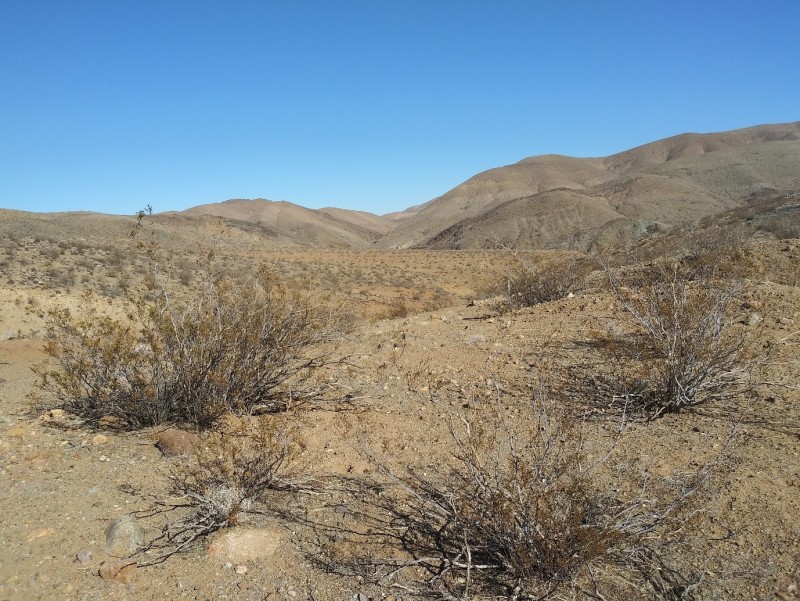
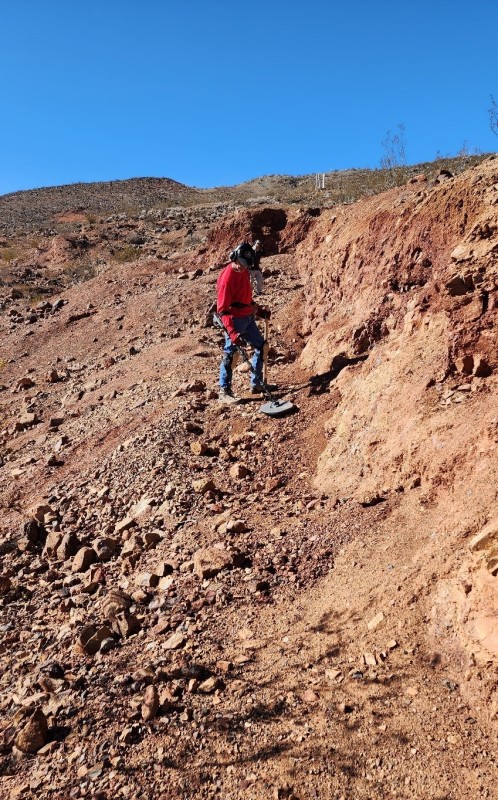
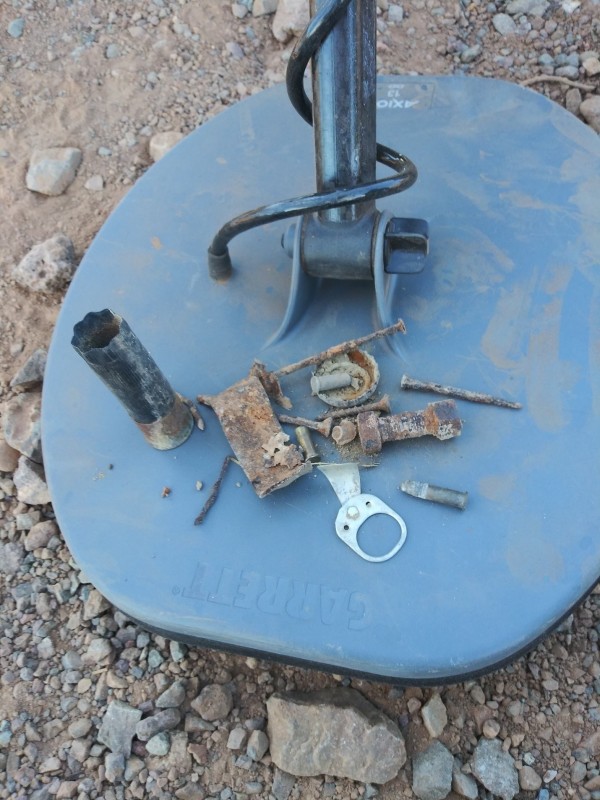
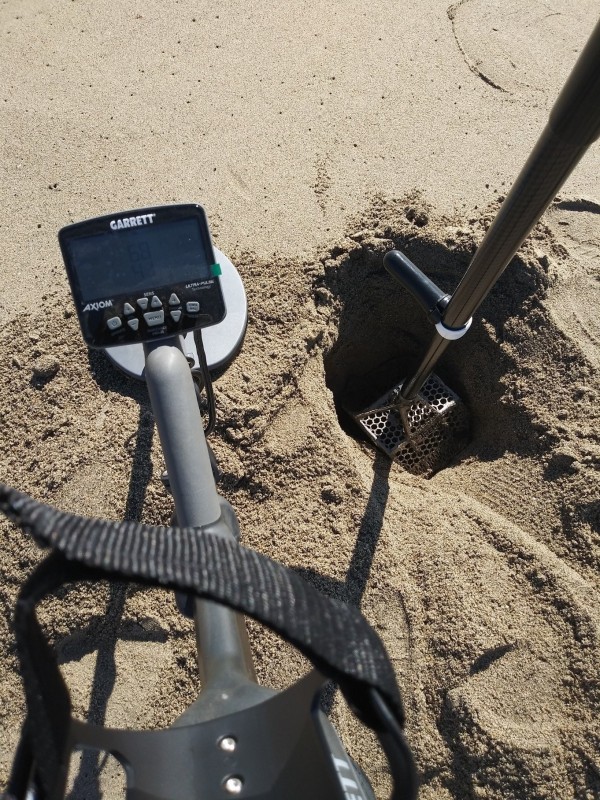
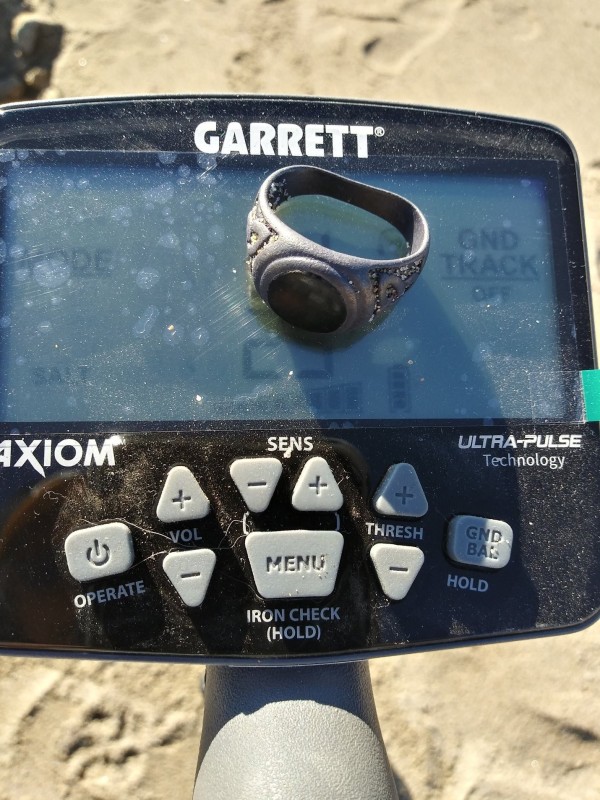

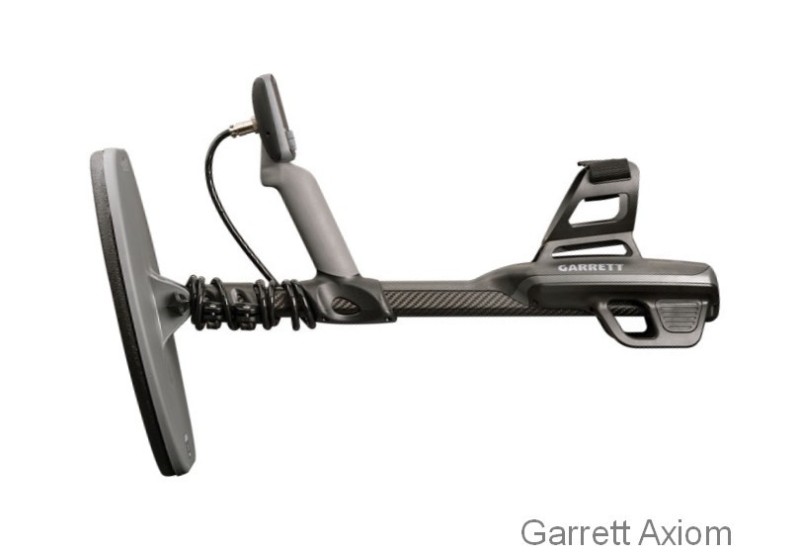

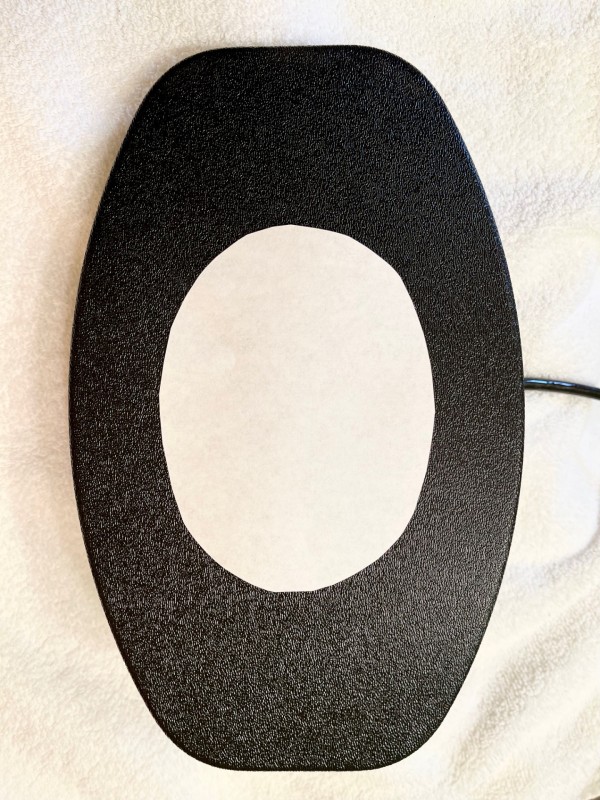
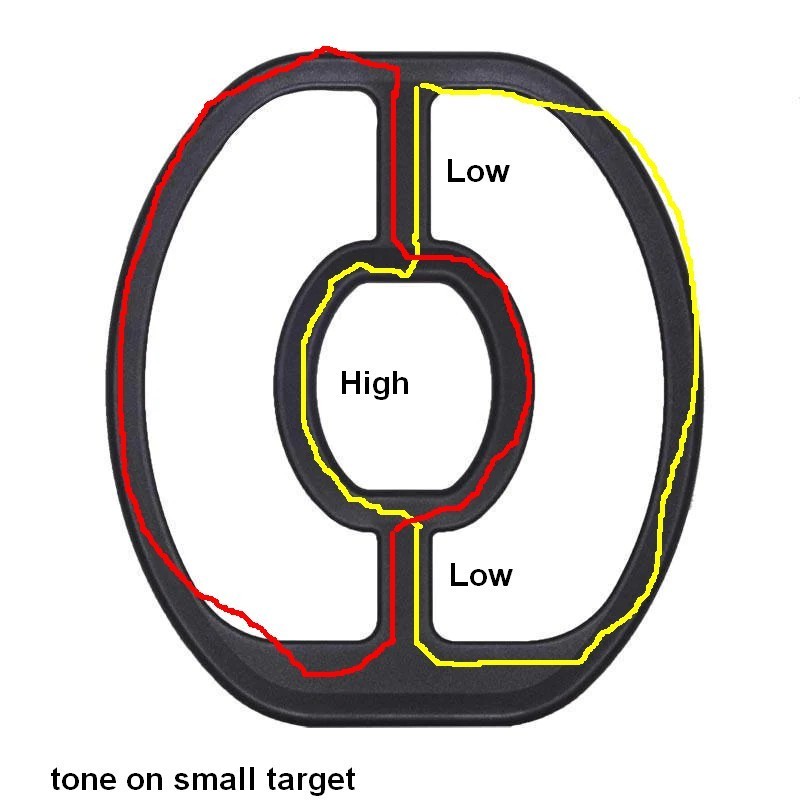

.thumb.jpeg.b5bdca008824846c84cee1662dd31f74.jpeg)
